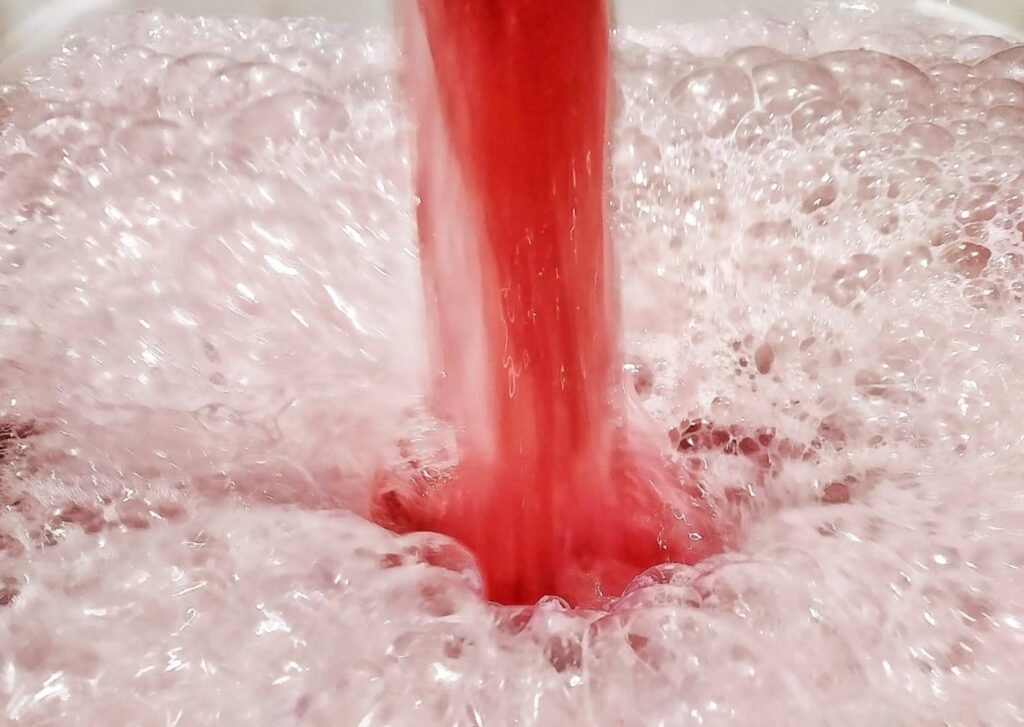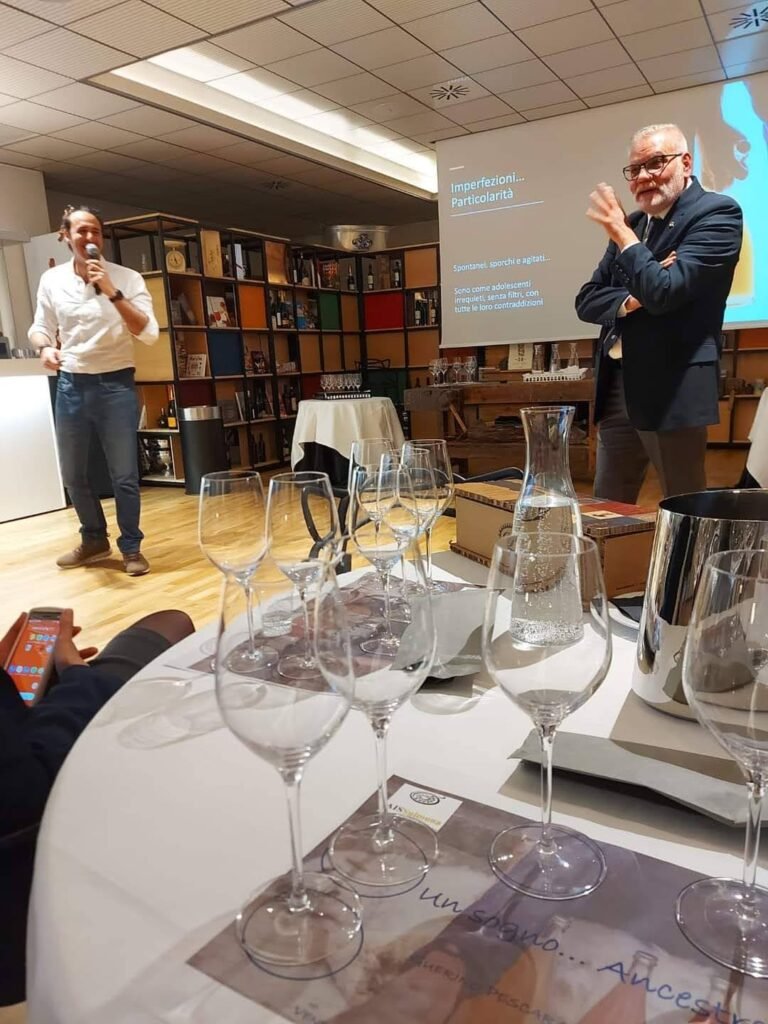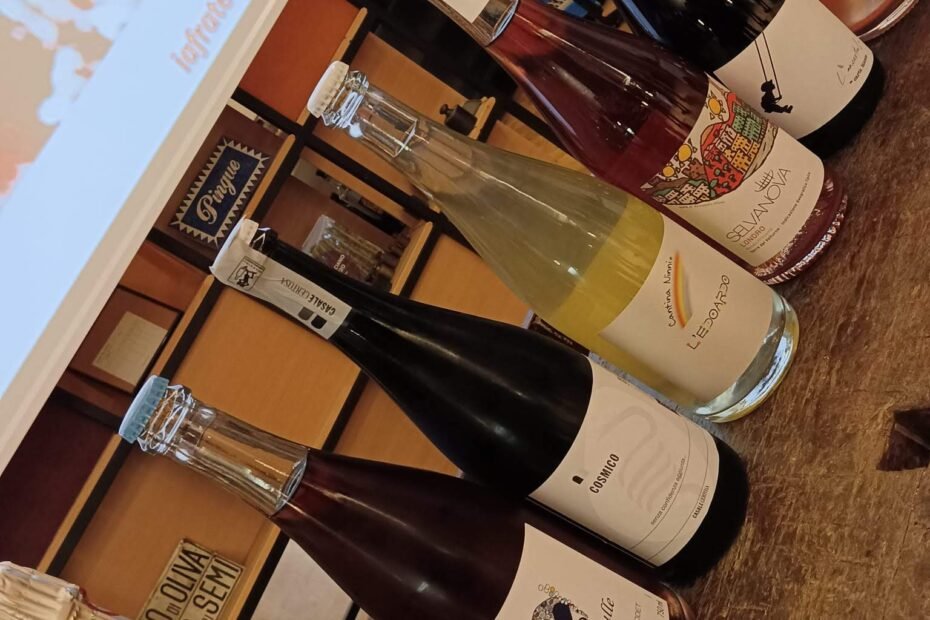Differently Ancestral
READING TIME: 7 minutes
MUSIC TO LISTEN TO: You’ve got a friend – Lucio Dalla – 1981
TEXT TO READ: Roma Caput Vini – Giovanni Negri, Elisabetta Petrini
No sooner said than done! On April 22nd, in the beautiful setting of Spazio Pingue in Sulmona, an interesting event took place to discover the fantastic world of Ancestral wines, in collaboration with the Italian Sommelier Association of Sulmona. It all started as a game during a gloomy winter Saturday. The histrionic Massimo Iafrate came to see me in my “headquarters” in Pratola Peligna and as often happens, when our meeting takes place, establishing a tone of seriousness between the two of us becomes a very difficult undertaking. Without conviction we jotted down some ideas, then others and so on, until we realized that the answer to our doubts was in my hands: a bottle of Ancestral wine! Why not have a tasting evening with these very special wines? Maybe! We were both linked by a deep desire to go outside the box. So we did!
There was a first path to take: drink so many ancestral… what a sacrifice! In fact, shortly thereafter I went to the “mythological” Luigi, historic restaurateur from Pescara, as well as proponent of numerous “acrobatic” wines in his restaurant, accompanied by a crew of thirsty colleagues. It was necessary to delve deeper into the subject:
Me: “Luigi, we have to study the ancestral ones, drunk on bubbles”
Luigi: “I have a shelf full of them, simply point your finger and start sabering, I have some traditional “Pet-nat”, “Col Fondo” and Ancestral, the choice is yours.”
Me: “I just wanted to taste an ancestral!”
Luigi: “Do you make it so easy?”

I actually didn’t know how many variations of tempting bubbles can be found under the name of “Ancestral” wines. Capturing the “ferment” may seem like child’s play, but there are many methods.
Traditional ancestral, “Col Fondo”, “Pet-Nat” are techniques that represent the watershed between sparkling wines and semi-sparkling wines, between the classic method and Martinotti. They perfectly embody a method with poorly defined boundaries, often overlapping, perhaps because they are closely linked to variegated craft techniques, whose history is rooted in that of peasant families where what was designed once cannot be changed, everyday wines capable of and a depth quite different from conventional wines.

All that remained was to organize the event, Massimo and I were ready, the Sulmonese delegation of the AIS Abruzzo was more aggressive than us, only one small detail was missing: choosing the wines. No problem, that’s what Il Biondo was for! Like any good self-respecting “pusher” he always knows which “ethyl pearl” to recommend. From north to south Italy the choice is very varied, in fact after a meeting full of reciprocal points of view, white smoke arrived on the wine list: a Trebbiano from Spoleto, a Trebbiano from Lazio, a Pallagrello from Campania blended with Aglianico and two rosés from Montepulciano rigorously from Abruzzo. Five very different ancestral wines. A touch of history was missing, the “Blanquette de Limoux”, the ancestor of Champagne, which thanks to the Benedictine monks of the Saint-Hilaire abbey, about 150 years before the well-known Dom Pérignon in 1531, began to work on winemaking techniques in the bottle. The list seemed done, but that wasn’t all! We had to “make it weird”, and so it was. For the last choice we moved to the Loire, land of great wines and spectacular cheeses. We could have chosen a classic Sauvignon Blanc or a typical Chardonnay but it would have been obvious. A rosé was what was needed, if then obtained from Gamay, Seibel and Grolleau even better! Now the wine list was really weird but comprehensive.

The term “ancestral” has always fascinated me, initially it took me time to understand the essence and typology of this wine, also because the term hardly connects to the world of “bubbles”, rather it leads back to the world of ancestors, to lineages and traditions felt as hidden and inexplicable. Only later did I understand its meaning, in making an ancestral we gloss over that tumult in the bottle, that ferment of the primordial change of the grape. Perhaps there was a desire to postpone this fascinating metamorphosis, to cage the movement that produces the effervescence of these wines. “Like taking a picture with a Polaroid”, says Massimo, “immortalize a moment and then shake the film to discover that what you see is not exactly what you expected”. If we then wanted to unleash them to remove the signs of the past, says Massimo, “they would become like listening to an incredible porn on the radio”.
There is an indisputable sensory pleasure in drinking these wines, their crunchiness has repercussions on the palate, easily recalling the drink. I think of the farmer wines that punctually resumed alcoholic fermentation in the spring from the few residual sugars they still possessed. Often kept in large glass demijohns, they were left to rest until the summer, the right time to enjoy a pleasant home-made “sparkling wine”. Perhaps it all started as a joke or, as often happens in artisanal wines, from a pleasant inconvenience, who knows! The imperfection of these wines is their peculiarity, exactly what you can find in an ancestral one, unexpected elements that become pleasant and satisfying for the taste. Dirty, agitated and spontaneous wines, like restless teenagers, without filters, full of contradictions, imperfect wines that seek their own dimension, do not like to take time, but transform over time.

The evening went on under the banner of improvisation, thanks to the madness of Massimo Iafrate and a fantastic audience fascinated by the subject. All the wines were pleasantly tasted as a surprise together with the guests, combined with considerations, jokes and a lot of amazement that gave movement to the evening, just like the ancestral “bubbles” we tasted, until arriving at the end with an obligatory reflection : How long do you have to wait to consume an ancestral wine?
Probably not much, they are not wines designed for the future but they are photographs of a moment. During the tasting we perceived that some producers play to make them elegant or very long-lived, others leave them intact without frills. Without a shadow of a doubt it doesn’t matter what they become, they are particularly interesting when we taste them in their immediacy, above all for the pleasant emotions enclosed in their evanescent bubbles.




